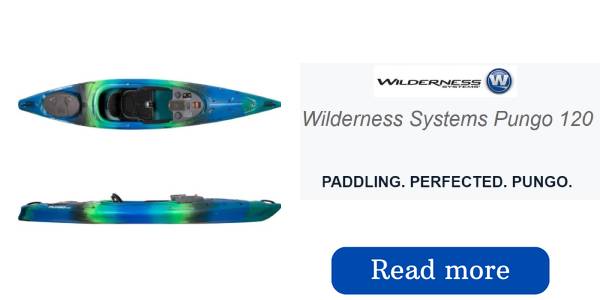An enjoyable outdoor journey can easily transform into a horrifying experience if you become unaware of where you are. Being lost out on the water becomes a much more serious problem if you are not close to people.
Would you not want to follow the same paths you love or locate the stellar fishing spot that you visited?
Having the most reliable GPS system for kayaking on hand can be of great assistance. What functions should be included on kayak GPS devices? And what makes the best GPS for kayaking?
Why Use A GPS When Kayaking?
GPS stands for Global Positioning System, and it is a method of satellite tracking that is owned by the US Government. Initially, it was created in order to locate submarines and function as a satellite navigation system for military operations.
The Federal Aviation Administration developed the technology.
A GPS can show you precisely where you are, tell you the direction you are going, direct you to a certain place, and provide details on your speed by means of arrows. A GPS device identifies your exact location by receiving transmissions from satellites and providing coordinate points.
GPS navigators are much appreciated by those involved in all kinds of sports and activities because of their capacity to be utilized for various tasks, for example travelling by car, kayaking, hiking, fishing, golfing and lots of others, since they offer very precise positioning and show angular velocity.
Exploring uncharted areas? With GPS satellite communication, you can follow your path and monitor where you’ve been so you can return to the same tracks in the future with Tracback.
If you’re out playing golf, you can use a GPS to precisely get the distance of each shot, and if you enjoy fishing, you can use the GPS to always come back to those successful fishing spots. This way, you will always remember those special places, because the system can save each location as a waypoint.
Kayak GPS Features To Look Out For
A GPS is a great accessory for any kayaker. Features to look out for include:
Water Resistance
Waterproofness is a very significant quality of a GPS to possess if you plan to go kayaking since it can experience splashes from your kayaking paddle, rain droplets, or even be dropped into the water if it is not held on to something strongly.
The most optimal GPS systems for kayaking are both waterproof and functional when submerged, though there are many that feature water resistance as opposed to being fully waterproof.
A majority of kayak GPS devices will carry a water resistant rating based on the IP code system. The higher the IP rating, the more water-proof the GPS unit is. You will likely need a gadget with an IPX7 water-resistance rating in order to go kayaking. This rating will safeguard against any accidental submerged water.
It is wise to buy a waterproof case when purchasing a unit with a rating of 6 or lower.
Size Matters: Keep It Small And Lightweight
When kayaking, space and weight capacity are restricted, so it can be beneficial to have a GPS device that is lightweight and can be transported easily, fitting well with the other items you are bringing.
You could wear some devices on your wrist as an option if you’re confined to a small area or would rather not affix it to your kayak. Some of these items come with heart rate monitors as an additional benefit.
Plenty Of Memory
Most GPS devices have a built-in memory system or the option to add a memory card to expand their storage space. The size of the device’s memory determines the number of waypoints, trails and maps you can store.
Certain items are equipped with an internal memory as well as the option for including a micro SD card for further storage.
Many GPS navigational systems feature the ability to save waypoints and trails, while some are even capable of saving routes. The distinction between routes and tracks is that routes are predetermined paths, while tracks are those that have already been taken by someone.
Long Battery Life
When planning a trip, it’s important to make sure your GPS won’t run out of battery while you’re in unfamiliar territory. Take into consideration a GPS system that has a good battery life and think about how you will power it while you are away from home.
You could possibly discover that certain machines are equipped with lithium-ion batteries, the same type of batteries found in cell phones and other miniature gadgets. These items are not heavy and can be charged up again, usually just like one would do with a phone.
Using other batteries such as AA for devices can be more cost effective. If you’ll be away from power for an extended amount of time, it can be more convenient to use a device with this kind of battery since you can bring some extras with you for an extended journey.
Good, Detailed Maps
Most GPS navigational systems generally feature some kind of pre-packaged map or chart, and most have the capability to load additional maps or refresh the current map through an online connection or via a Bluetooth connection.
It may be necessary to buy separate maps for more thorough maps of a certain area or buy an annual BirdsEye Satellite Imagery registration. If the device has limited space inside, you may not be able to keep many maps and you might not be able to take advantage of saving points of reference or graphical tide patterns.
Certain instruments may have additional capabilities and more complex navigating applications than others do, for instance waterways or geological representations, or even lunar data.
Some GPS systems may come with maps that possess shaded relief which gives a further illustration of the landscape like mountains, valleys, steep canyons, and more in detail, offering a wider view of the territory’s elevation.
Compatibility
Certain GPS gadgets are likewise GLONASS good, which is a Russian satellite route network that uses 24 satellites, not at all like the US’s 31 satellites for GPS.
Having a GPS system that utilizes both GPS and GLONASS systems can provide you with an incredibly precise location, a precise position fix map, and an incredibly accurate timing. GLONASS compatibility can be a useful feature to have.
Best Kayak GPS in 2023
Best Overall: Garmin GPSMAP 66i
The measurements of this handheld type device are 6.4×2.6×1.4 inches and it only weighs 1.28 ounces. The battery can last 35 hours in 10-minute tracking mode and 200 hours in Expedition mode.
If you need a combination of reliability, sturdiness, and flexibility, this Garmin GPS instrument is exactly what you’re seeking. It is light enough to be held in one hand effortlessly, the weight is only 1.28 ounces, and it can be stored in any sort of bag, pocket, or pouch.
The GPS system can be used with both GLONASS and Galileo. It has 16 GB of internal storage capacity, so there is plenty of space to save multiple maps.
The GPSMAP 66i provides you with the convenience of getting satellite imagery free of charge, eliminating the requirement of a subscription to access different maps. You can program up to 20,000 distinct destinations and favorite places, observe up to 250 GPS paths, as well as catalog 300 exercise routines using this service.
This device is quite compact yet its display is surprisingly vast; it comes equipped with a 240 x 400 pixel resolution providing clear visibility of the small details on your maps. With Garmin’s optional inReach satellite service beginning at a low rate of $15 per month, you are able to utilize weather predictions, a two-way text message service, and track your location.
Even if you find yourself in a precarious position, emergency mode can be triggered, connecting you with trusted search and rescue teams available at all times. No matter where you go, you can be certain that you will stay connected and safe due to the 100% global coverage provided by inReach.
This product is ideal for any kayaking excursion because it has an incredibly long battery life of 35 hours and its construction is ample for enduring a strenuous trip.
Pros:
- Sturdy and reliable
- Includes access to BirdsEye satellite imagery, no subscription needed
- Sizeable and highly detailed screen
- Works as a cellphone
- Lightweight and compact
Cons:
- Won’t clip onto your backpack or PFD
- Software/OS is buggy, prone to crashing
Best Wearable: Garmin Instinct Solar
This wearable device measures 1.77 x 1.77 x 0.6 inches and weighs 5.61 ounces. Its battery life is virtually unrestricted when it is in Battery Saver mode and receiving sunlight.
If you are looking for a GPS tracking device that you can use without having to use your hands, then Garmin’s innovative smartwatches are a revolutionary choice. The Instinct Solar has great GPS software while also providing a solar-powered charging feature that keeps the battery running for longer.
This timepiece can be submerged up to a depth of 100 metres, is constructed according to U.S. armed forces criteria, as well as being both thermally and surprise-resistant. This device offers all of the typical functions for keeping track of workouts (heart rate, pulse oximeter, activity tracking, counting calories, sleep monitor, and more), plus access to GPS, GLONASS, and Galileo systems, along with a barometer and tri-axis compass.
Moreover, the Garmin watch is not only rich in features, but is also proven to be durable and dependable. It is a perfect option for activities such as kayaking, swimming, diving, motorbiking and mountain biking. Although it’s portable, be assured that you can always remain in command and linked to your end goal through its Global Positioning System functionalities.
Pros:
- Rugged and versatile fitness tracker with smartwatch and GPS capabilities
- Thermal, shock, and water-resistant
- Fitness and wellness-tracking features
- Highly reliable
Cons:
- Plastic body
- On the pricier side for a fitness tracker
- Small screen makes it hard to read GPS tracks
This handheld device measures 2.13 x 1.3 x 4.06 inches and weighs 5 ounces. It has a battery life of up to 25 hours when two AA batteries are used.
Want to keep it cheap? Go with the Garmin eTrex 10! This item is extremely inexpensive compared to more expensive models on our list—all for a relatively low price—yet it still provides a lot of features for your kayaking adventures.
This handheld navigator has been constructed to be durable, with a strong casing and specialized handle that will be comfortable to grip even when your hands are moist. The battery life on this device is remarkable, with up to 25 hours of use on only two AA batteries. This product is able to withstand immersion in water up to a certain depth, as well as any rain, spills, and even overturning.
This device has WAAS-enabled GPS, as well as HotFix and GLONASS support. The display of the GPS device is rather small, being only 2.2 inches, and only displays your maps in black and white, making it no where near the most sophisticated possible.
Nevertheless, with the straightforward topographic maps that are incorporated, it is possible to assign directions, trace one’s paths, and measure altitude. For the price, you just can’t beat it!
Pros:
- AA battery power makes it easy to keep charged—just bring a few extra pairs in your gear!
- Compact, lightweight, and sturdy
- Budget-friendly
- WAAS-enabled, includes HotFix and GLONASS support
- IPX7 waterproof
Cons:
- Can’t clip onto your backpack or PFD
- Monochrome screen isn’t very detailed
Best for Staying in Touch: Garmin inReach Explorer+
Size: 1.5 x 2.7 x 6.5 inches Weight: Half a pound Duration of Use: 30 hours
Are you planning to take a canoeing journey with some friends or with your family? Do you simply wish to ensure that your family and friends are aware of your current location? This GPS device can be used to ensure you stay connected to others continually.
With the push of a button, you are able to provide real-time notifications of your whereabouts, making it easy for others to trace your movements anywhere, from the ocean or a river. In the event of an emergency, you can set off the embedded SOS signal to notify the 24-hour search and rescue services that assistance is needed.
The battery in the device is powered by lithium-ion technology and allows you to use the device for up to 30 hours on one charge. It can be conveniently rejuvenated with either a solar energy charger or a portable battery pack.
To be ready for your journey, link your cell phone to Earthmate and get any of the free maps you need. You have the ability to view and utilize aerial images in color and those from the United States. The National Oceanic and Atmospheric Administration offers maps which allow one to outline the most effective route in light of the existing weather and land features.
You can utilize the inReach Explorer+ application to access preexisting topographic maps and plan out your journey ahead of time so as to make your expedition even more effortless. In addition, you’ll be equipped with a barometric altimeter, accelerometer, and digital compass to make sure you stay on the right path.
Pros:
- Features include two-way messaging, tracking/location-sharing, global interactive SOS, and built-in navigation tools
- Includes pre-loaded topographic maps, plus access to more via Earthmate
- Easy to set and follow navigational waypoints and routes
- Cloud-storage included, great for trip planning ahead of time
- 100% global satellite coverage
Cons:
- User interface isn’t intuitive or user-friendly
- Poor customer service/technical support
in conclusion
Investing in a high-quality GPS can make your kayaking experience safer, more enjoyable, and more efficient. With features like water-resistant design, pre-loaded maps, and waypoint marking, a kayak GPS can be an invaluable tool for any paddler.
Remember to choose a GPS that suits your specific needs, whether that’s for recreational use or for more advanced kayaking activities.




